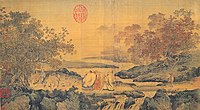



In Chinese philosophy, the three teachings (Chinese: 三教; pinyin: sān jiào; Vietnamese: tam giáo, Chữ Hán: 三教) are Confucianism, Taoism, and Buddhism. The learning and the understanding of the three teachings are traditionally considered to be a harmonious aggregate within Chinese culture.[1] Literary references to the "three teachings" by prominent Chinese scholars date back to the 6th century.[1] The term may also refer to a non-religious philosophical grounds of aggregation as exemplified within traditional Chinese medicine.
- ^ a b "Living in the Chinese Cosmos: Understanding Religion in Late-Imperial China". afe.easia.columbia.edu.